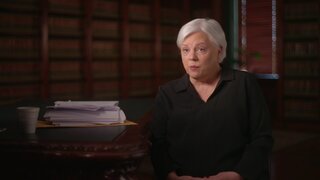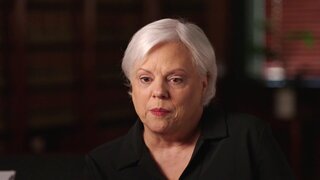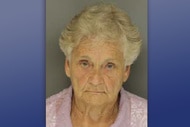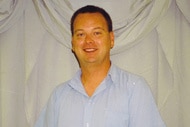Create a free profile to get unlimited access to exclusive videos, breaking news, sweepstakes, and more!
Prosecuting Evil Finale Revisits Robert Durst's Trial for the Death of Morris Black: "We Were All Played"
Galveston authorities said "all hell broke loose" when learning the suspect in the death of Morris Black came from one of New York City's most influential families. The suspect, Robert Durst, would later be suspected of killing three people, including his missing wife.
Prosecuting Evil’s Kelly Siegler gives audiences a behind-the-scenes look into the controversial acquittal of Robert Durst, a man yet to become one of America’s most well-known murderers.
The Texas case against Robert Durst began in September 2001 when a local found a human torso floating in Galveston Bay. Officers from the Galveston Police Department arrived on the scene, finding additional black garbage bags in the water containing severed human limbs.
A then-unidentified man’s two arms and leg were fished from the waters; the second leg washed ashore not far from the scene. The missing head was never recovered.
“It kind of seared into your memory, if you will,” responding Galveston P.D. Officer Gordon Morse said in the Prosecuting Evil with Kelly Siegler Season 1 finale, available to watch on Oxygen and Peacock. “It’s hard to forget.”
RELATED: Police Investigate Men's Love Triangle in 1987 Cold Case of Murdered Elderly Couple
The Murder of Morris Black
Fingerprints helped authorities identify the victim as 71-year-old Morris Black, a local man described as a loner who kept to himself with little to no relatives. Despite the publicity surrounding his killer, little would ever be known about Morris Black.
“Why would anybody want Morris Black dead, and why would anybody need to mutilate his body in such a horrible way?” wondered Kelly Siegler.
Authorities also discovered several vital pieces of evidence: A discarded newspaper addressed to an Avenue K residence; an eviction notice to Black; and an eyeglass prescription for someone named Robert Durst.
Investigators soon went to Black’s Avenue K apartment, finding numerous clues pointing to Morris Black’s violent end.
“Inside Morris Black’s apartment, there was blood in the drain, the sink, the shower; certainly evidence that would indicate that blood was being washed down the drain,” said Joel Bennet, who was the Galveston County First Assistant District Attorney at the time. “And they found evidence of blood in the hallways, leading from Morris Black’s apartment to the apartment across the hall.”

The second apartment reportedly belonged to Dorothy Ciner, and inside, detectives found blood spatter on the walls consistent with a gunshot wound. Since a postmortem examination determined that neither Black’s torso nor severed limbs sustained a gunshot wound, authorities determined Black died after being shot in the head.
A .22-caliber pistol and a shell casing found in an outside trash bin supported the theory.
Police also found drop cloths and cuts on the linoleum floor, supporting the theory that Black’s body was dismembered in Ciner’s apartment.
When questioned by police, Ciner claimed she went to high school with Robert Durst, whose name was found on the eyeglass prescription with Black’s body. However, a librarian told detectives that they regularly spotted Ciner and Black together, claiming Ciner was really a man dressed in women’s clothing.
It would later transpire that Robert Durst was using his former classmate’s name to hide his true identity.
Police arrested Durst after an employee at the eyeglass business called detectives and reported Durst was there to pick up his prescription. Inside Durst’s S.U.V. trunk, police found spots of blood that would later test as a positive match to Morris Black, as well as a bow saw.
They arrested Durst on murder charges but became puzzled when Durst — a seemingly lowly man of little means — posted $250,000 bond the following day.
“At that time, I got a call from a New York Times reporter asking me to look at an old photo and see if it’s the same Robert Durst,” said Bennet. “From there, all hell broke loose.”
Not only was Durst the son of one of New York City’s most prominent real estate magnates and billionaires, but he was also suspected in the 1982 disappearance and presumed murder of his wife, Kathleen Durst, in Westchester County, New York.
Years later, he’d be suspected of killing close friend Susan Berman in an execution-style shooting that occurred in December 2000 in Los Angeles, less than a year before Morris Black’s death.
Dream Team Legal Defense
Millionaire Robert Durst had unlimited resources, and soon after posting bond, he was in the wind. Despite public appeals by his influential relatives and attorneys, Durst spent 45 days free until he was picked up for shoplifting a sandwich in Bethlehem, Pennsylvania, about 1,500 miles from Galveston.
At the time, he’d shaved his head and assumed the identity of Morris Black.
For the murder of Black, Durst hired the best Texas attorneys money could buy, including Dick DeGuerin, Mike Ramsey, and Chip Lewis, the former of whom opposed Kelly Siegler in the high-profile case of Dror Goldberg.
District Judge Susan Criss for the 212th District Court presided.
“This case was not going to be a whodunnit,” Judge Criss told Prosecuting Evil. “It was going to be a whydunnit because with the amount of forensics that you have, cutting a body up, they’re going to be able to tie back something with the DNA to Durst. That’s unavoidable.”
Durst’s defense didn’t deny that the defendant fatally shot Black, dismembered his body, and put him in Galveston Bay. However, it became a question of whether Durst committed the shooting with intent, by accident, or in self-defense.
“We knew the atrocious, vicious facts, what they were,” attorney Chip Lewis told Prosecuting Evil. “The question was how the hell do we get this jury to look at what happened versus all the sh-t he did afterwards that makes him look, not only guilty, but like a very dangerous, calculated killer.”
RELATED: How a Teenage Love Turned “Crazy Wrong” Prompted the Murder of Adrianne Jones
Lewis said he and his colleagues had “all the money in the world” to defend Durst. They began with a motion for a change of venue, which would have cost the county a solid six or seven figures when factoring in transportation and accommodations for jurors, the judge, attorneys, and everyone else needed in the courtroom for the duration of the trial.
Durst’s “dream team” proffered to retract the motion in exchange for individual voir dire, meaning Lewis could individually question each juror in the jury pool during jury selection. The trade-off was approved, and Lewis formed a rapport with those holding Durst’s fate in their hands.
“Strategically, what [Lewis] did playing that card was brilliant,” Siegler admitted. “I’ve never seen it done before that way. Ever.
Why Durst didn’t want to be found legally insane
The trial of Robert Durst was slated to begin on September 22, 2003. However, days before proceedings could begin, 36 hours of jailhouse conversation (recorded at a Pennsylvania jail following Durst’s arrest) between Durst and his wife, affluent real estate agent Debrah Charatan, were made known by legal parties.
Kelly Siegler said the tapes captured Durst’s true “essence and character,” but Judge Susan Criss found they had no bearing in the murder of Morris Black. Only a limited amount of the recordings was allowed to be entered as evidence.
According to Judge Criss, Charatan — whom Durst married in December 2000 — was concerned one of Durst’s legal reps would convince him to plead insanity.
“The problem was the family trust had a provision that if he was ever found insane or incompetent in a court of law, he would be eliminated from the trust,” Judge Criss told Prosecuting Evil.
Per clips of the conversation, as published by Prosecuting Evil, such a ruling would deem his making Charatan power of attorney invalid. Charatan told Durst it was “too risky” to let Durst’s lawyers become the default guardians of the trust, which was worth around $750 million, according to Lewis.
Judge Criss said the defense wanted to “portray him as having some mental illness without using it as an actual defense.” For this reason, the defense introduced Durst’s upbringing, which included witnessing his mother’s suicide at a young age and possibly having a spectrum disorder.
To drive the point home, attorneys purposely dressed Durst in oversized clothing and lowered his seat to aid the illusion that he was just a small man, especially when purportedly up against the likes of a more intimidating Morris Black.
“We didn’t need a jury to like him,” said Lewis. “We needed them to understand he’s a strange bird.”
The issue at hand was whether the defense could prove that Durst killed Black in self-defense. The wound to Black’s head could have potentially proved Durst acted with intent (i.e., execution-style), but Black’s head was never recovered.
Robert Durst takes the stand

Kelly Siegler said calling Durst to take the stand was a “risky” move, but that was precisely what the defense did. Judge Criss even allowed Durst to leave the witness stand and reenact his version of events, demonstrating each move with his lawyers in what Criss called a “choreographed” routine.
Jurors found Durst charming, sometimes laughing at his wit.
“They were riveted,” Lewis said of the jurors.
The defendant described his friendship with Morris Black, explaining that he gave Black his apartment key at some point. The friends later argued, resulting in Durst taking the key back.
On the day in question, Durst said he returned home to find Black sitting in Durst’s apartment uninvited. Black allegedly refused to leave, and an argument ensued, prompting Black — who reportedly knew where Durst kept a pistol — to fetch the weapon and threaten Durst.
The pair got into a physical altercation, and the gun accidentally discharged, killing Black after a bullet hit the victim between the eyes, according to Durst’s testimony.
Prosecutors, however, pointed to Durst’s acts following Black’s death for why he was a cold-blooded killer.
“You don’t cut people up after an accident,” said First A.D.A. Joel Bennet, adding that Durst dismembered Black’s body “with the skill of a surgeon.”
A Shocking Verdict
During closing arguments, Lewis argued that jurors’ “sole purpose” was to decide whether Durst acted in self-defense instead of focusing on what Durst did with the body postmortem.
In 2003, Robert Durst was found not guilty of killing Morris Black, a decision that brought the defendant visible relief.
“Everybody in the country, especially everyone in law enforcement or with a prosecutorial background, thought that this was the greatest layup of all time,” Defense Attorney Chip Lewis told Prosecuting Evil. “But criminal justice for the Dursts of the world is far different than the average citizen.”
Lewis added, “Justice isn’t black or white, it’s green. And he had the green."
“I don’t want to believe that just because a defendant has a lot of money, he can subvert the system and walk away with a not guilty verdict and not get justice,” said Kelly Siegler. “A disaster happened, and it makes me sick.”
“It was a pretty awful moment because I have to act like I don’t have an opinion about it,” Judge Susan Criss said of the verdict. “But in my head, I’m thinking, ‘Oh, my God, this guy’s really dangerous, and he’s about to be loosened on the public.’”
Following the acquittal, Robert Durst donated $1 million toward a new law library in Galveston.
Jurors, such as Joanne Gongora, would have a change of heart years later when Durst was charged with the December 2000 death of Susan Berman in Los Angeles, California.
“You find out all this stuff afterwards, and I just felt like we were all played,” Gongora told Prosecuting Evil.
In March 2015, Durst was arrested in New Orleans, Louisiana, for the first-degree murder of Susan Berman and once again represented by Dick DeGuerin and Chip Lewis to face charges in Los Angeles County. Prosecutor John Lewin alleged Robert Durst killed his wife, Kathleen, in Westchester County, New York, in 1982 and that he confided information to his close friend, Susan Berman.
“And then he had to kill Morris Black because Morris Black knew who he was and was putting pressure on him,” Lewin said at the Berman trial.
In 2021, Durst was found guilty of killing Susan Berman and sentenced to life in prison without the possibility of parole.
“There was a lot of satisfaction in watching the outcome of the Los Angeles trial because it did feel like he was being accountable,” said Judge Susan Criss. “Not just for Susan Berman’s murder, but for Morris Black and for Kathie Durst’s murder.”
Three months into serving a life sentence, Robert Durst suffered a heart attack and died in prison.
Neither Kathleen Durst’s body nor Morris Black’s head has ever been found.
Catch up on Season 1 of Prosecuting Evil with Kelly Siegler on Oxygen.

































